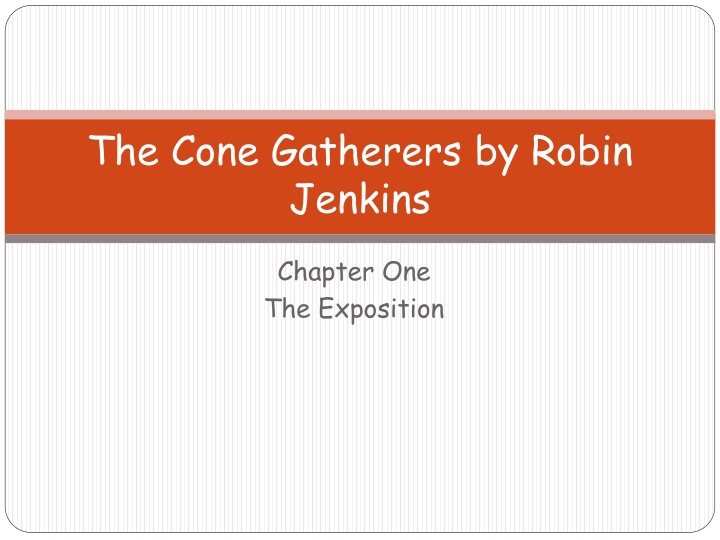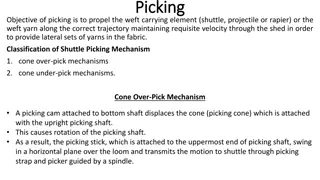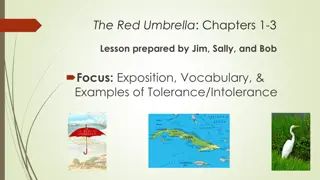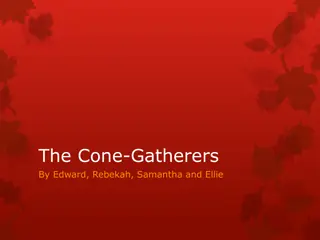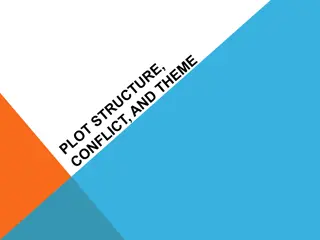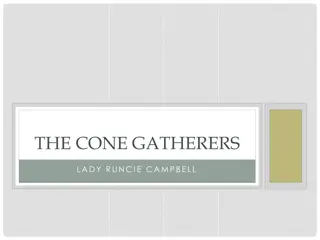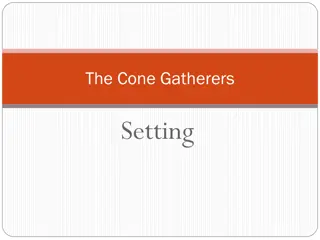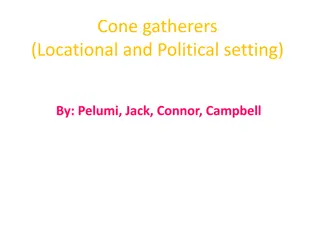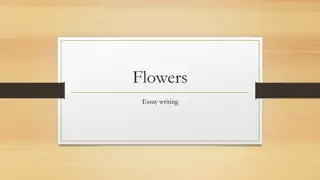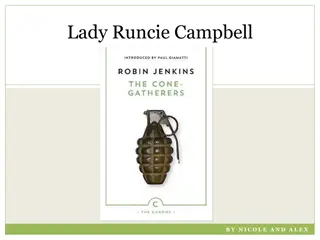Character Analysis and Exposition in "The Cone Gatherers" by Robin Jenkins
The exposition of "The Cone Gatherers" introduces the characters, their relationships, sources of conflict, setting, narrative voice, motifs, symbols, and foreshadowing. Calum is depicted as having a deep affinity with nature while exhibiting childlike innocence and sensitivity. Neil struggles with bitterness, inequality, and the weight of war, sacrificing personal desires for his brother. Duror harbors intense hatred towards Calum and Neil, revealing disturbing characteristics and feelings that drive his actions. These character dynamics set the stage for the unfolding narrative as tensions rise in the story.
Download Presentation

Please find below an Image/Link to download the presentation.
The content on the website is provided AS IS for your information and personal use only. It may not be sold, licensed, or shared on other websites without obtaining consent from the author.If you encounter any issues during the download, it is possible that the publisher has removed the file from their server.
You are allowed to download the files provided on this website for personal or commercial use, subject to the condition that they are used lawfully. All files are the property of their respective owners.
The content on the website is provided AS IS for your information and personal use only. It may not be sold, licensed, or shared on other websites without obtaining consent from the author.
E N D
Presentation Transcript
The Cone Gatherers by Robin Jenkins Chapter One The Exposition
The exposition The exposition of this novel introduces: Characters Relationships between characters Sources of conflict and tension Setting The narrative voice Motifs and symbols Foreshadowing of later events The writer s style
Calum Affinity with Nature, at home up in the tree- as indigenous as squirrel or bird chaffinches fluttered around him Seems to represent goodness and innocence- the birds land on him and his face was alert and beautiful with trust So close to Nature that he can imagine himself as an owl he became an owl . But cannot understand why creatures he loved should kill one another . Does not understand war, so he just pushes it from his mind Sensitive- cannot bear to see animals suffering ( The rabbit in the trap.)- but can t kill them to put them out of their misery
Calum He is childlike- crying sobbing and whimpering over the rabbit. He has a deformity- a hunchback- but a beautiful face. He is simple ( his mind has not really developed beyond childhood). He is agile in the trees but clumsy on the ground Relationship: he trusts Neil absolutely. He loves his brother- helps him down from the tree. Would have stayed up in the tree all night.
Neil Bitter- he hates where they have been forced to live- in a box fit for monkeys . He dislikes the inequalities caused by class Yonder s a house with fifty rooms .nearly all of them empty. We re human beings just like them. We need space to live and breathe in. Theme of class conflict ( Also page 4- But it wouldn t have hurt them .what the grand folk once used. ) The war seems to weigh heavily on his mind. He loves his brother but is frustrated by his childishness. ( The rabbit) To look after his brother he gave up the chance of marriage He has to worry for both of them-hates the job, but worries about losing it- where would they go/ what would they do?
Duror (characteristics and feelings) Hatred of Calum. Feels revulsion towards him. Imagines killing him (and Neil). He thinks it would not be murder (because to him, they are not human) He compares it to frogs being squashed crossing the road. He feels the woods- his stronghold and sanctuary- have been polluted by the presence of the two men. (Page 9) He is strangely drawn to the two men despite his hatred of them and finds himself obsessed by them, spying on them, waiting for them etc. He feels humiliated by this: He had waited over an hour ..Runcie Campbell. (p9) It is like he is a third brother. He has a ungovernable aversion to anything with an imperfection- Since childhood ..lack He approves of Hitler s killing of idiots and cripples not in general abstract terms, but when he sees Calum.
Duror He feels a tree of revulsion growing inside him. At times he feels physically shaken by the hatred and revulsion like a tree in a gale. He cannot understand why so many healthy intelligent men are killing and being killed, and yet Neil and Calum are allowed to live in peace. In Europe, in Africa and China ..sub humans lived in peace, as if under God s protection. The accumulated horror of the compulsion he has against anything deformed is about to be let loose due to the arrival of the cone gatherers (Foreshadowing)
Sources of conflict and tension Neil s bitterness about how he and Calum are being treated (by the grand people in the big house )why they cannot live in the summer house, but have to live in a tiny hut. (Relates to theme of class conflict/ social inequality) Duror s irrational hatred of the cone gatherers ( this is a key factor in the development of the plot and the build up of tension towards the climax.
Setting (time and place) Set during WW2. The war is constantly in the background of the novel. On the first page, a destroyer and aeroplanes are mentioned- even in this secluded place, the war cannot be escaped. Calum hates to think about the war- cannot bear the idea of people killing each other.(shows his goodness) Neil refers to the war when telling Calum off for being so soft hearted- the horrors of war are being highlighted. Duror refers to the Nazi idea of the perfect Aryan being- people like Calum were executed by the Nazis. This creates horror in the mind of the reader, that Duror could even think like this. (Relates to the theme of the battle between good and evil) The forest is secluded and isolated, allowing tensions to build
Narrative voice Although the novel is written in the third person, the writer does use the technique of indirect free discourse , meaning that we hear the thoughts of the characters in their inner voice. This is especially obvious with the character of Duror when he is thinking about Calum. in an icy sweat of hatred, with his gun aimed all the time at the feebleminded hunchback grovelling over the rabbit. To pull the trigger .and then to hear simultaneously the clean report of the gun and the last obscene squeal of the killed dwarf..
Motifs and symbols The tree of revulsion and hatred growing inside Duror is a major motif which appears throughout the novel ( to represent his growing insanity). The imagery is especially appropriate because of the setting in the forest; because Duror used to find sanctuary in the trees, and because he himself is later described as a strong tree which has somehow gone rotten.
